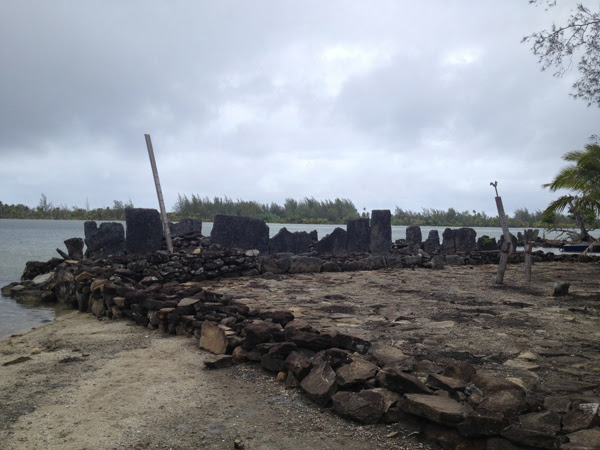 |
| Local archeologist/guide picked us up in his jeep |
 |
| Maeve marae today |
We then headed towards the fish traps to check out the
process. Fisherman built large narrow rock passages, with a central round end…
the tide comes in.. with all the fish. The fish swim over the walls, and when
the tide recedes, the larger fish get trapped in the narrow channel…. Then it
is only a matter of scooping them out, very ingenious. In addition to seeing
the fish traps, we stopped along the way to see fresh water eels, and visited a
vanilla plantation to pick u fresh vanilla.
 |
| One of the many fish traps located inland - tide comes in and fills traps with fish when it recedes |
After the fishing experience, we headed to the motu (a reef
islet formed by broken coral and sand surrounding an atoll/island) on the
eastern side of the island. Motus are land ridges poking out of the water. They act as a barrier on one side of the
lagoons that general surround the mainland. The lagoon formed between the pieces
of land is generally calm because of the protected waters. The ocean on the other side of the motu is
rougher and the tides hit hard there.
(If you saw Castaway with Tom Hanks, you get the idea of what it might
be like to cross over these outer areas).
 |
| Bonita on motu |
 |
| Marla enjoying the beach |
We walked into town and had vanilla smothered mahi mahi for
dinner, and a tropical drink. We finished off the evening drinking at the beach
house watching the sunset. I drank a bit too much and ended up needing a nap.
Ryan kept handing me drinks…. Allow Ryan is quiet and a little soft spoken, I
have noted that he is the instigator of the group. Everyone was smiling soon - Bonita
was considering having the Tahitian Beer label tattooed on her body… (the one
with the island girl citing with a red dress and lots of flowers)… we decided
it didn’t go well with the rest of her tattoos.
I woke up with a bit of a
hangover, and a decision to back off on the alcohol. I lasted 3 days of
drinking heavily. The sun, the drinking, and the heat were catching up… more
water please! Ryan came by with a glass of vodka and orange juice (at 7 a.m.)
and asked me if I was ready to start the new day drinking. Ugg. I
The final day on Huahine, the
gang scored a boat from a local French Guy and opted to go out along the motu
and reefs and do a bit of snorkeling. I, still green in the gills from the
night before, opted out. The last thing I needed was a boat ride. (Also recall
that I am a little fraidy-cat when it comes to water). Instead, I took the car
(the beach house comes with a car), and drove the entire road system of the
island. It was roughly 28 miles. The drive was like traveling through a large
garden…mostly coastal, with only two areas that rose about the ocean. When I
say coastal, I mean coastal! It was like a thin narrow strip of tarmac along
the rocky beaches. It was very curvy.. And there were no guard rails or street
lights. (The French, like the Canadians, do not believe in guardrails). If you
were driving at night and not paying attention, you could easily drive into the
ocean (sometimes on both sides).
Most of the island was remote, very little people, a few
pensions scattered here and there. It was not until I got to the very end of
the island that I came across another village, but no real services. The people
would see me come by and wave and smile and say hello in Tahitian.
 |
| The people here are very friendly |
Huahine was a very quiet place to relax off the beaten path.
The lodging was not that expensive, roughly $250/night to rent the entire
house. We used the car, so we had to pay for the gas.
 |
| Jeep ride around island |
 |
| Snacks - fresh bananas |
We caught an island hop and headed for Bora Bora, the place
where all people dream of going someday….
*A marae (in New
Zealand Māori, Cook Islands Māori, Tahitian)
malaʻe
(in Tongan), malae
(in Samoan) and mālaʻe (in Hawaiian[1])
is a communal or sacred place that serves religious and social purposes in Polynesian societies. In all these languages,
the word also means "cleared, free of weeds, trees, etc." It
generally consists of an area of cleared land roughly rectangular (the marae
itself), bordered with stones or wooden posts (called au in Tahitian and Cook Islands Māori) perhaps with terraces (paepae) which were traditionally used
for ceremonial purposes; and in some cases, a central stone ahu or a'u. In the Rapanui culture of Easter
Island "ahu" has become a synonym for the whole
marae complex). -wikipedia

No comments:
Post a Comment